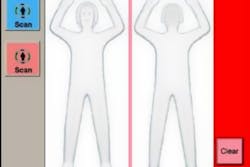Report: Radiation exposure from backscatter body scanners negligible
The results of a new report commissioned by the American Association of Physicists in Medicine (AAPM) has found that the radiation concerns previously expressed over the use of X-ray body scanners in airports that use backscatter technology were largely overblown.
In fact, the report found that people absorb less radiation from X-ray backscatter imaging machines than they do actually standing in line for the scan itself.
According to measurements made on two scanners in active use at Los Angeles International Airport, as well as seven other scanners not in active use at the time of the study, the backscatter full-body scanners were found to deliver a radiation dose equivalent to what a standard man receives every 1.8 minutes on the ground or every 12 seconds during an airplane flight.
In effect, a person would have to receive more than 22,500 scans in a year to reach the standard maximum safe yearly dose determined by the American National Standards Institute and the Health Physics Society.
"This report represents a wholly independent review of the X-ray scatter airport scanners and is the first we know of to look at multiple scanners including those in actual airport use," said Christopher Cagnon, PhD, DABR, the chief of radiology physics at UCLA Medical Center and one of the lead authors of the new report. "We think the most important single take-away point for concerned passengers is to keep an appropriate perspective: the effective radiation dose received by a passenger during screening is comparable to what that same passenger will receive in 12 seconds during the flight itself or from two minutes of natural radiation exposure."
These findings are a moot point, however, when it comes to body imaging machines currently being used at U.S. airports. Earlier this year, the Transportation Security Administration removed all of the backscatter body scanners in use across the nation in favor of machines that use millimeter wave technology to meet privacy standards enacted by Congress.
About the Author
Staff Reports
Editorial and news reports authored by the media team from Cygnus Security Media, including SecurityInfoWatch.com, Security Technology Executive magazine and Security Dealer & Integrator (SD&I) magazine.
